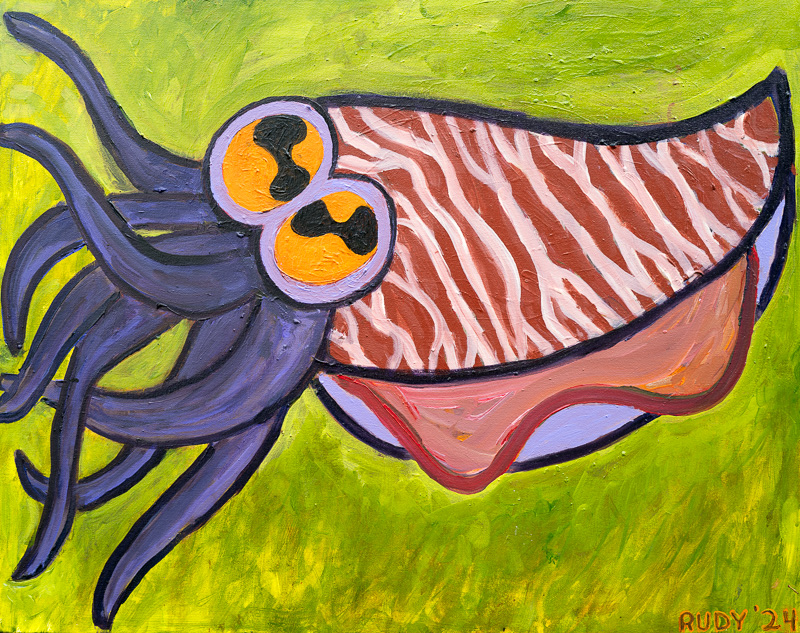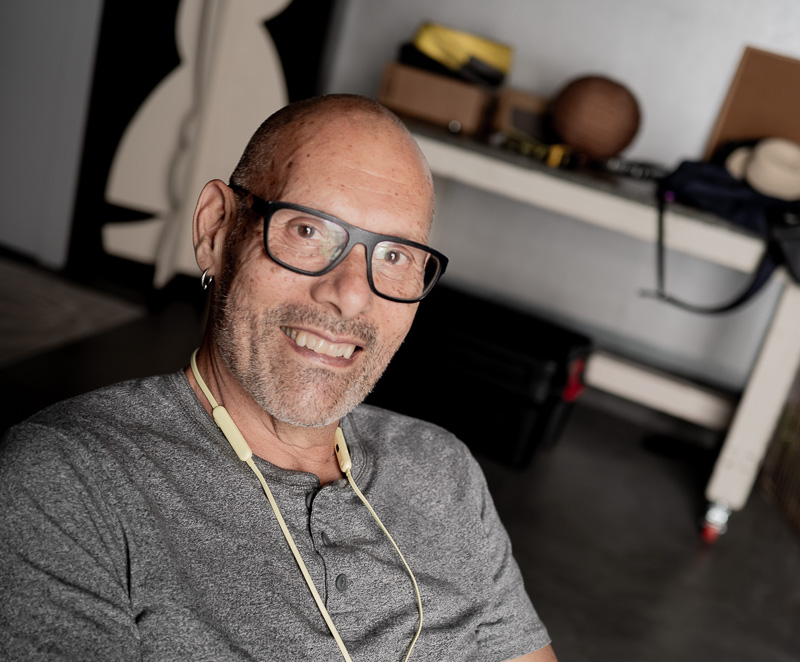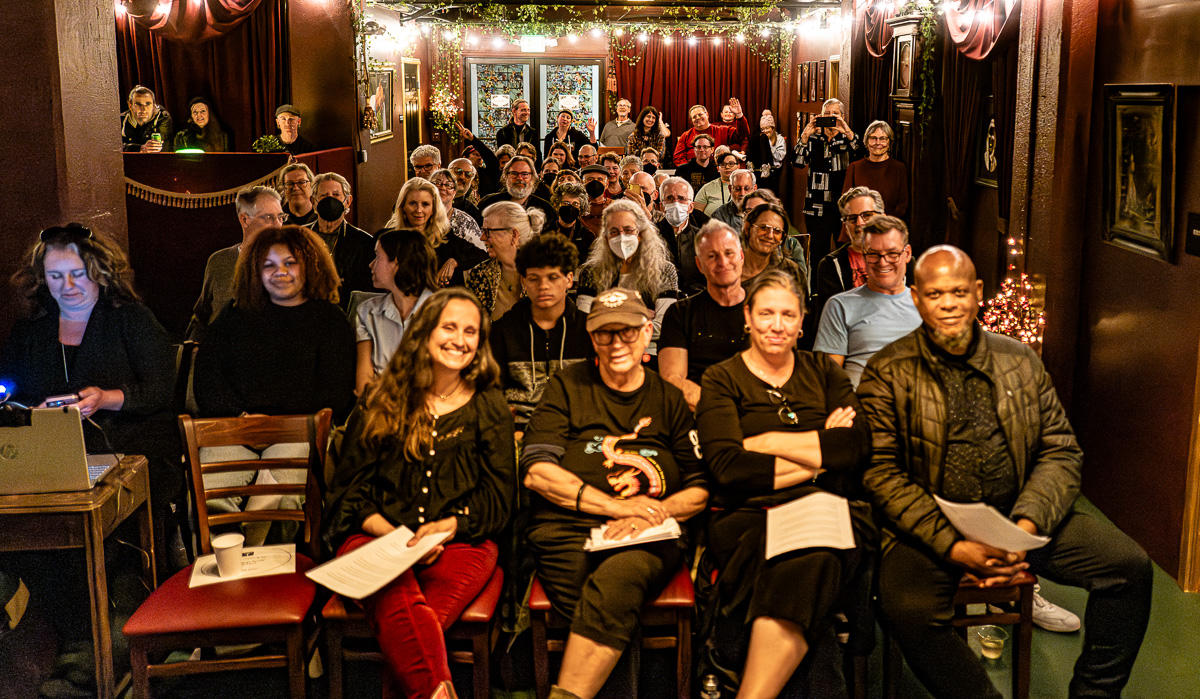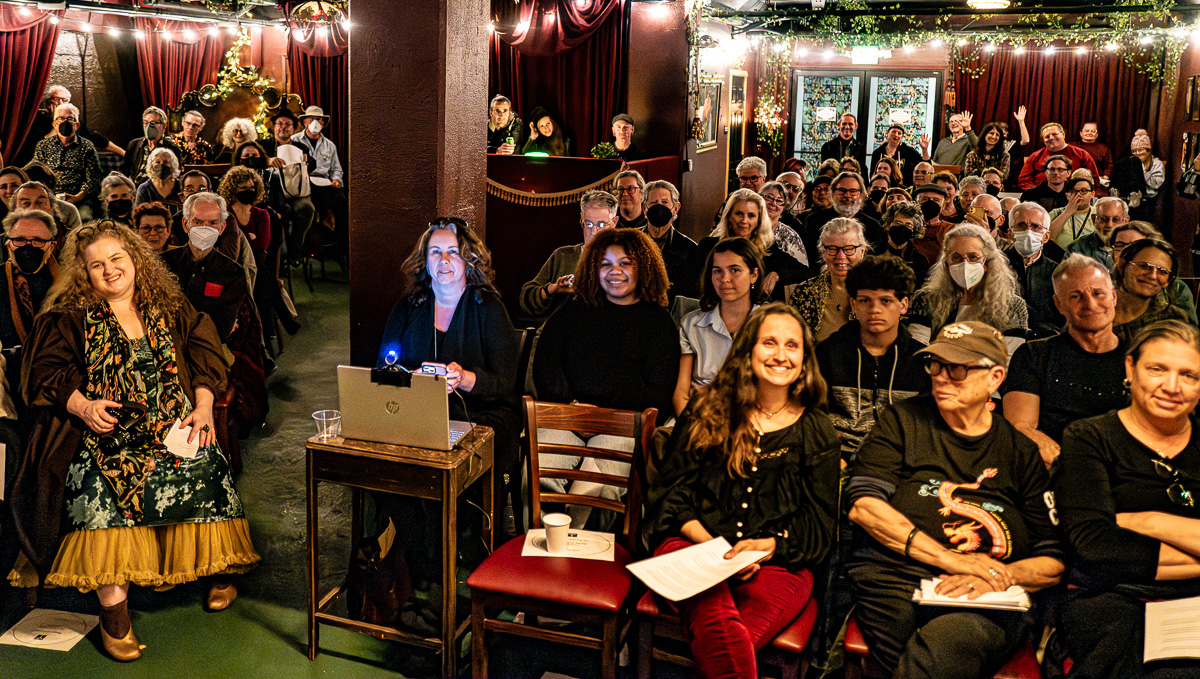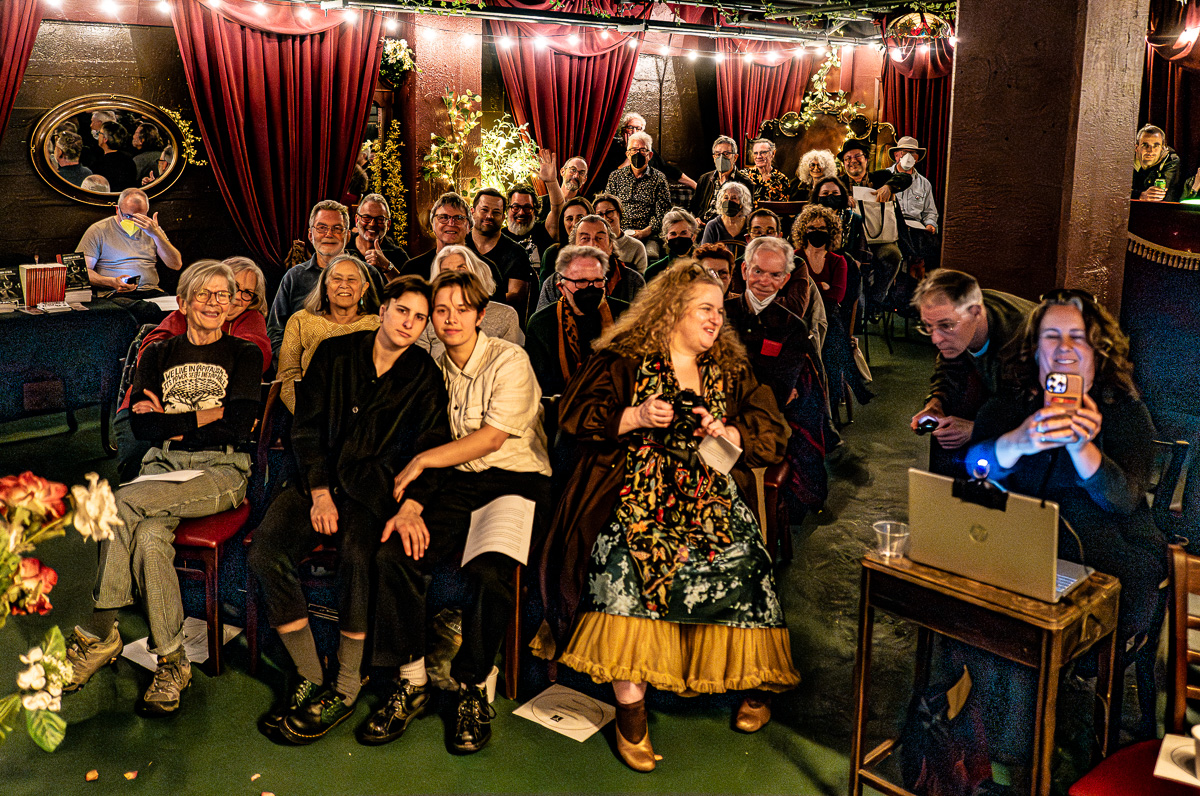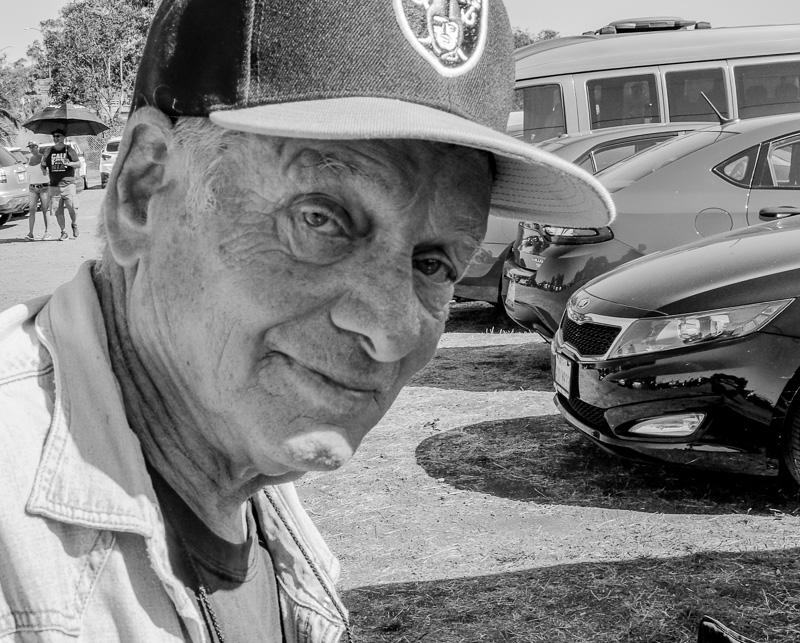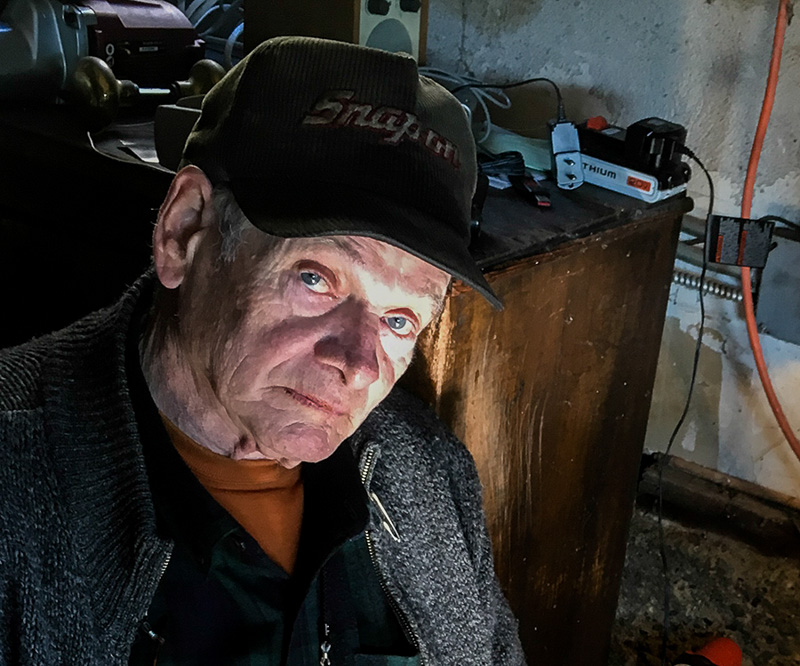This is the text of “Big Germs,” a strongly anti-gun story that I read at the SF in SF gathering in San Francisco on Sunday, June 23, 2024. This post appears on Medium as well. And you can hear a podcast version. One more option is that you can read a longer and more polished version of “Big Germs” that appeared in BoingBoing on May 22, 2024.
I’ve dreamed of this story for so long, and now it’s over. And I don’t think it’s too short. The quick hit feels right. The idea is that two young women conjure up some ethereal jelly-bag critters evolved from human blood cells—these are the big germs of the title. The big germs have minds, and they reproduce, and you can talk with them. The women ask the big germs to zap all the guns and weapons in the world and turn them all into dust. End of problem.
So good to have that story done after thinking about it for so long. It was wonderful to regain my writing mojo and once again to revel in my craft.
No idea what I might write next, and not gonna fret over it yet.
To liven up my post I’ve pasted in some more-or-less random images, mostly of my paintings.
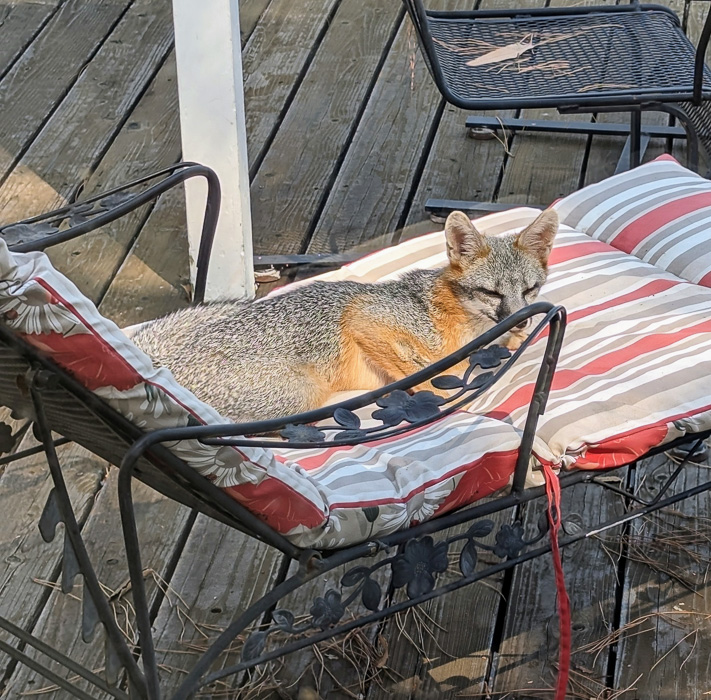
Zoe sits on the steps behind her family’s house. Her dog Bowser lies flopped on the damp earth. It’s April in California. Zoe savors the neighborhood sounds, copying her sensations and her comments to an uvvy patch on the back of her neck. An uvvy is a type of tweaked sea slug, and uvvies grant their users a sort of telepathy, which is called teep.
Zoe is making a tangle, based on sights, smells, sounds, and memory flashes. The process? She elaborates her inputs into a virtual quilt. And then, to make it a tangle, she wraps a flow around the quilt. The flow is a network of links or, looked at another way, it’s like the script of a film.
Once you’ve got your tangle you teep it to someone wearing an uvvy. The tangle settles in and—the user gets a sampling of your memories, yens, and dark dreams. And the sample is never quite the same. In a certain sense a tangle is alive, and it has a mind of its own.
Zoe’s early tangles were abstract, like high-tone gallery art. Sounds, not words; shapes, not things. Her tangles resembled silk scarves inside dusty suitcases. Open a case, and Zoe’s visions float.
Then then Zoe changed her style. She started collaborating on her tangles with her pal Bix. More ironic now, more commercial. Barbie Doll houses, Ukrainian Easter eggs, Mondrian paintings. Cheery, antic, off-kilter. Fun.
But all that was then, and this is now. Thing is—three months ago, a school shooter murdered Zoe’s younger brother Nick. Nick with his shrill voice, his many opinions, his skinny, lively legs—eternally active—except when he’d sink for hours into hand-drawing levels for imagined video games. He liked to pretend he was a superhero, leaping at Zoe from a perch atop the couch. But none of that kept him safe.
After the murder, Zoe kept obsessing that there was something she could have done. Like keeping Nick home from school that day, not that she could have known the particular day, but what if? Or at the very least, she could have helped Nick dream up a strategy for escaping shooters.
Zoe had nightmares, and she cried a lot while she was awake. The grief surging at her like a foul, oily wave. She felt guilty about all the times she could have been nicer to Nick, but hadn’t been. Horrible, horrible, horrible.
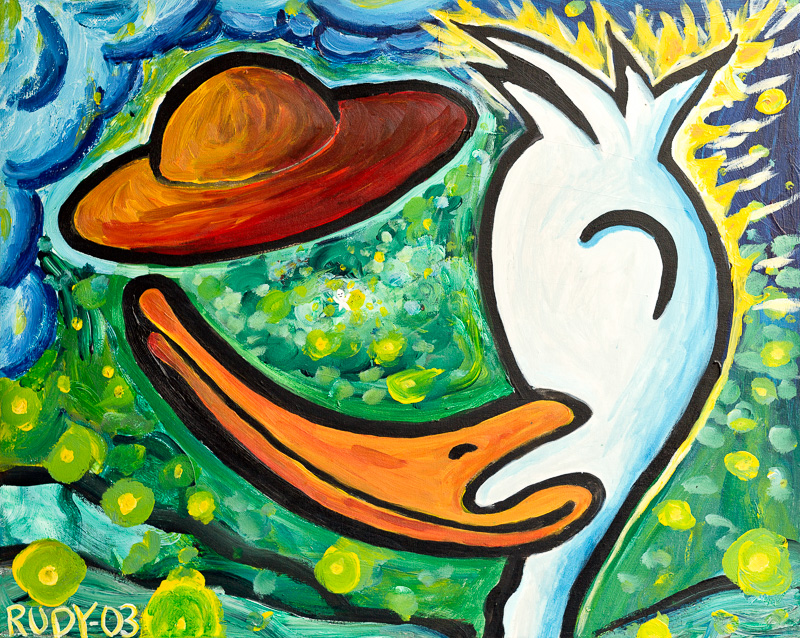
She got into such a state that for a month she blanked out. Lay in bed all day staring at the wall. Frozen. Finally her friend Bix had jolted her loose by snaking the garden house in through Zoe’s window and seriously drenching her.
“Hydrotherapy!” Bix had cried, with her face a mask of forced joviality. “Be happy!” With her eyes full of tears.
It made Zoe feel sorry for Bix. Sorry for someone other than Nick and herself. And that was a start. She got better. But let it be said that Zoe’s Mom never really did forgive Bix about the damage to the bed and the carpeting. Not that Mom wasn’t glad to have Zoe back. “But did you really have to use the garden hose?”
Bix convinced Zoe to get back to making tangles with her. A good move. The tangles obscured the looming specter of raw grief. Working on art has a way of driving off the other thoughts.
Zoe and Bix’s latest tangle is Dough Ray Me—about a sun god made of cookies. Very pretty, very happy, very meh. Zoe regretted it.
Bix was saying they could demo Dough Ray Me at today’s Sound Off jam in downtown San Jose. Not far from their yup burb of Los Perros.
But Zoe is thinking that if they’re going to the Sound Off, they ought to bring something better. That’s what she’s doing sitting on the back steps. Making something cool. A crooked kraken creeping from a crypt. And who knows how. Just start it and finish it.
Zoe believes that if you’re really tuned in, the synchronicity feeds you the clues you need. It’s like the Muse says hi, and the world collaborates. Like stained glass lit by a heavy Sun.
A car drives past: an assassin. The wind in the trees: the universal mind. The jabber of the neighbor’s gnome-bot: a periwigged colonial gent snipping the gun amendment from the Constitution. A woman coos to her quacky tot: her ponytail is a fountain of tears. Birds in the hedge: triangular beak-cheeps, a bullet factory. A carpenter hammers a nail: the tones rise toward crisis.
The killer rakes his fire across Nick’s thin chest. Sodden blurts of blood. The sad boy’s final cry—cut off. Too much? Leave it in. People need to feel it. And end with coroner samples of Nick’s blood cells, ultra-high-res loops of the live cells jiggling.
“Yo, Zo!” Enter Bix, shyly smiling.
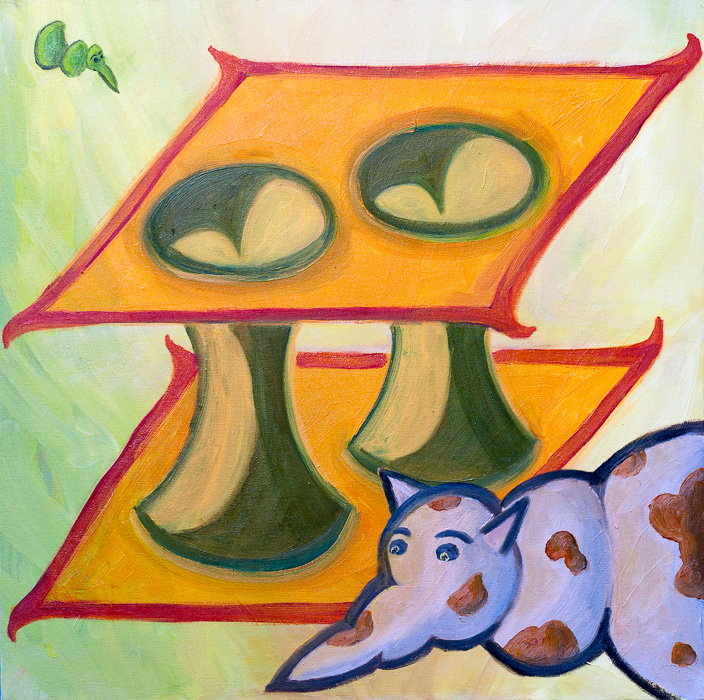
Zoe draws a deep breath. “Greetings, comrade,” says she, in the light tone they use together. “What news from the front?”
“We’re in! I demoed Dough Ray Me to the gatekeeper. She slobbered over it. Your back-story helps. We’ll show it this afternoon. First session of the Sound Off workshop!”
“Plucky gals in tangle tussle,” says Zoe, talking weird for her recording. “Come none, come tall.”
Bix pauses, assessing the situation. “You’re starting a new tangle?”
“We can’t use Dough Ray Me,” says Zoe. “It’s empty. Like an ad for moo. If I’m in this jam, I want to stink.”
“I hear you, girl. But—do you think we can finish a whole new tangle in the next three or four hours?”
“I’m amassing clips, hooks, and scabs as we speak,” goes Zoe. “My quilt billows. Almost done. Five minutes long. This sad old world is beautiful. As for your side of things, I’m thinking we use the same flow you made for Dough Ray Me.”
“Use the same flow twice?” cries Bix. “You don’t understand flow at all. Showy strutter that you are. Vapid, leg-kicking Vegas Rockette.”
“Your pique is counterpoint to my torque,” goes Zoe.
“Idiot.”
“Now for the quilt’s final patch,” says Zoe, unperturbed. “Bowser!”
As he wakens, the old dog begins scratching his neck, same as usual. His rear leg thuds repeatedly against the damp earth. Zoe nods to the beat, digging it. Bowser staggers to his feet and does a full-body shake, flapping his ears against his head.
“Lucious,” murmurs Zoe. “It’s a metaphor, Bix. And yes, I grasp that you’ll need to change your flow a little. But less than you imagine. Everything fits. Always.”
Bix is getting curious. “The fleas are the victims, and Bowser’s the school killer?”
“The fleas are the guns,” says Zoe. “And Bowser is our tangle. The Nick tangle. We’ll be the horsemen of the catalyst. Terrorizing the gun fiends.”
“Would be nice,” says Bix.
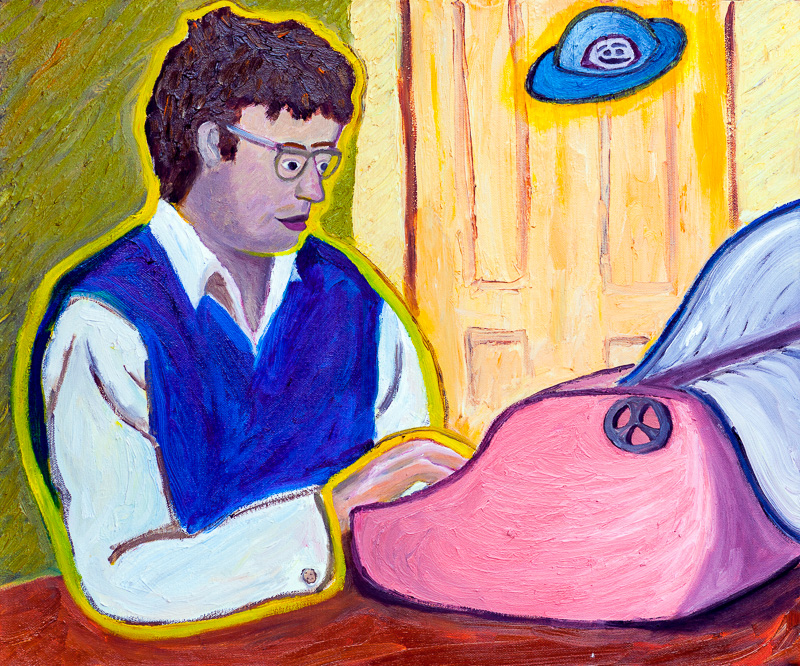
Zoe raises her hands, as if addressing a large audience. “Thank you, thank you, thank you. The long nightmare ends.” She opens her mouth wide and wheezes from the back of her throat, emulating a cheering crowd.
“Brave little trumpeter, you,” goes Bix, pacing back and forth. “But how does the Nick tangle do anything real? It’s just sounds and shapes. Visions and vibes. Yes, a tangle is a alive, and it spawns copies of itself. But—it destroys guns—how?”
“Nick’s blood cells are inside the tangle,” says Zoe. “I copped nanoscale lab videos. Add a few touches, and the simmie cells will morph into true slime warriors for our cause. A cell is as smart as a human, you know. Wolfram’s Law of Computational Equivalence.”
“Pile on the bullshit and keep a straight face,” says laconic Bix. “I want to believe. Say more about how your simmies will morph into matter?”
Zoe looks uneasy, maybe even embarrassed. “Okay, right, we’ll get help. From, um, someone at the Sound Off show?”
“Our session is at four with Schrank, I Did Not, and the two Swillies. They’re sisters.”
“Schrank is teen horror,” says Zoe, thinking it over. “I Did Not is fun with mirrors. Never seen the Swillies live. Are they dank?”
“Tingling tent-worms. Puddles of smeel.”
“We join forces with them,” says Zoe. “They’ll dig your wry, crab-sideways flow.”
Bix thinks for a minute, then nods. “Why not. We act like morons and wrap your Nick quilt in my Dough Ray Me flow and see what the fuck happens.”
The women sit side by side on the back steps, running the fused Nick tangle, in full teep contact. The tangle feels like it’s much longer than five minutes. It’s hella dank.
“Queen of quilts,” says Bix, elbowing her pal. “Sometimes finds even the blind hand an acorn.”
This is a saying the girls like. It comes from Bix’s self-effacing Hungarian grandmother, who says it, not without irony, whenever she gets something right. “Sometimes finds even the blind hand an acorn.”
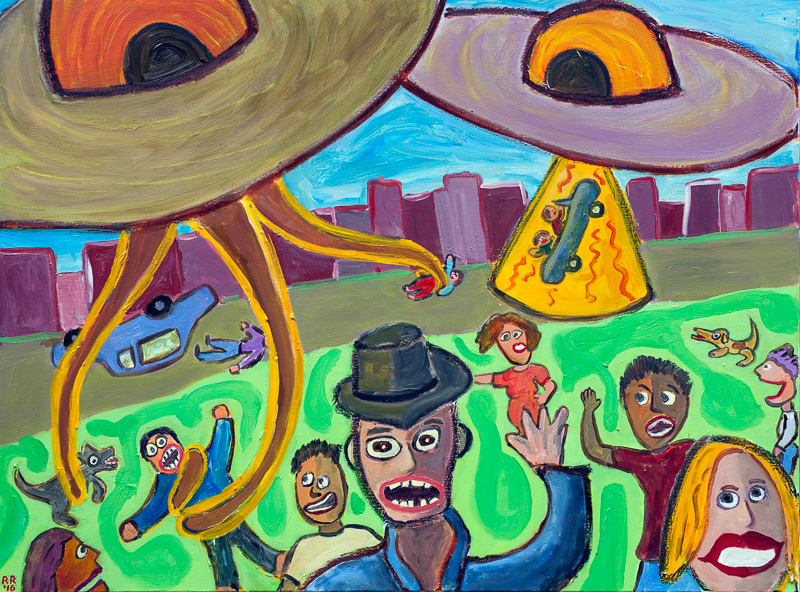
“Always remember that a tangle is a little different every time it runs,” says Zoe. “Not a circle repeat, but an upward helix. Evolution. The simmies of Nick’s blood cells will learn to do a no-guns thing. And then, I swear it, they’ll turn real.”
“Visualize, realize, actualize,” says Bix. “Blind hand. Ball lightning. Those blood cells are truly Nick’s? Tres sick. We’ll pep them up, yes.”
The women touch their heads together for a deeper level of teep. Bix shapes her flow into a sculpted river with bulges. Not a flat river, you understand, an intricately knotted loop in space.
Zoe cannonballs a virtual Nick into one of the river’s bulges. Then another and another. The dog-paddling Nicks whoop and wave. Bix and Zoe push mental energies around the loop. It glows like lazy neon. And, yes, the grisly blood cells are morphing into kindly, cozy microorganisms. Paramecia and amoebas. The little Nicks whistle to them. They tumble like a cheer squad.
“Big germs,” says Zoe.
“I wouldn’t exactly call them germs,” protests Bix. “Don’t germs have to be bacteria?”
“Any small critter is a germ,” insists Zoe. “Colloquial usage.”
The Sound Off workshop is in the San Jose civic auditorium, a 1930s building styled as if made of adobe, with creamy curves and arches. The arena’s wooden floor has tables and stools, with, um, only a hundred attendees, and maybe two hundred more in the low, smooth, adobe benches along the walls.
Tangles aren’t yet a popular art form. You need to be wearing an uvvy to view them, and a lot of people are paranoid about having a biotweaked sea slug on the back of their neck.
The Schrank crew are dressed in Goodwill chic. Non-binary, like shaggy cartoons. Three of them. They raise their arms for attention and the crowd quiets. Everyone’s uvvy picks up a bombastic trumpet fanfare, as if for some primeval rock show. And then the users get their Schrank tangle downloads. It’s called Granny Goose. Sounds playful, but it’s not.
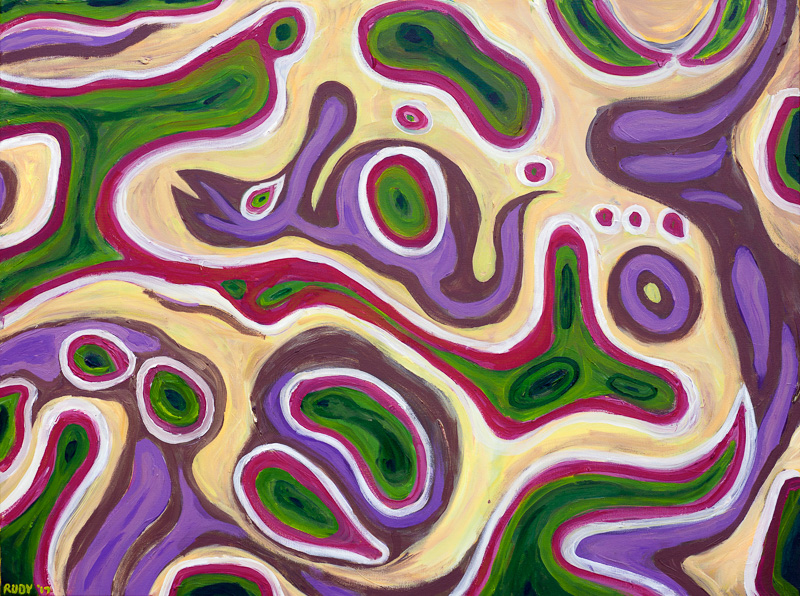
Experiencing this tangle, Zoe and Bix are in a mild blue sky, in their own forms. Flocks of flagellates and ciliates swoop and wheel like starlings at dusk. Giant microbes. Zoe feels these are her creations, engendered by her hi-def animated images of Nick’s blood cells.
In the next group’s tangle, Zoe and Bix see the protozoa again, translucent and gleaming, bigger than dogs. Nuzzling them.
“They’re more detailed now,” says Bix. “We’re polishing their code.”
“There’s got to be a way to teach them to destroy guns,” Zoe says to Bix.
“I’m almosting it,” Bix responds.
And now it’s Bix and Zoe’s turn.
“Are you ready?” Zoe shouts to the crowd.
“Ready for Nick?” echoes Bix, right with it.
The friends get into a back-and-forth chant. At first it’s out loud, but as they send the Nick tangle to the users, they switch to teep, and it’s not even clear who’s saying what.
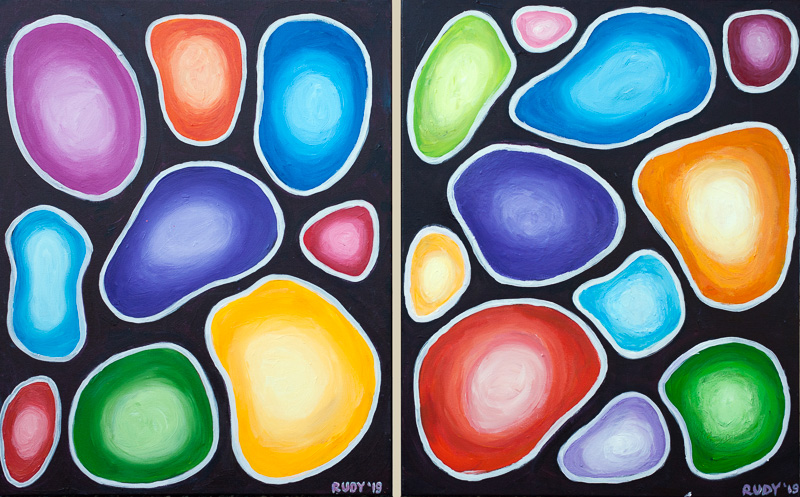
“Nick’s dead.”
“He lives!”
“In our tangle.”
“The bangle-wangle!”
“A killer shot him!”
“We’re gonna take the guns away.”
“We’ll grow big germs.”
“We’re gonna take the guns away.”
The tangle kicks in. It’s similar to what Bix and Zoe designed, but—more edgy and jittery. The stage fright is in there, and the dread of seeing Nick die.
The big germs are busy in the tangle, more of them than ever, blobs on every side. Zoe teeps Help Nick as the killer appears. And, yes, as the assassin raises his assault weapon, a paramecium channels a bright beam that crumbles the misshapen rifle into bright dust. And with that, this run of the Nick tangle ends.
Zoe is agog. Their plan—it can work! The hall fills with cheers for the brave save. And under all that are—bellows of anger? Yes, it’s a pair of gun lovers. Low crude beasts with moronic slogans on their T-shirts. One has a beard, the other is bald.
Are Bix and Zoe going to be safe? Odd that Zoe hasn’t thought to worry about this before. She’s been so blindly sure of her triumph. But, at least for now, the haters aren’t coming for her.
With the help of the Swillie sisters, Long Sue and Jeen, they launch an improved version of their tangle again. The tangle spreads to everyone’s uvvies. Zoe sees a movie marquee, with a title in lights. Saint Nick. A heavy stage curtain hangs from the marquee.
An elfin chorus sounds—and the curtain parts.
Zoe and the others imagine themselves to be walking through the opening—and then they’re in the San Jose civic auditorium, same as before, right where they started, and they’re not watching a tangle anymore.
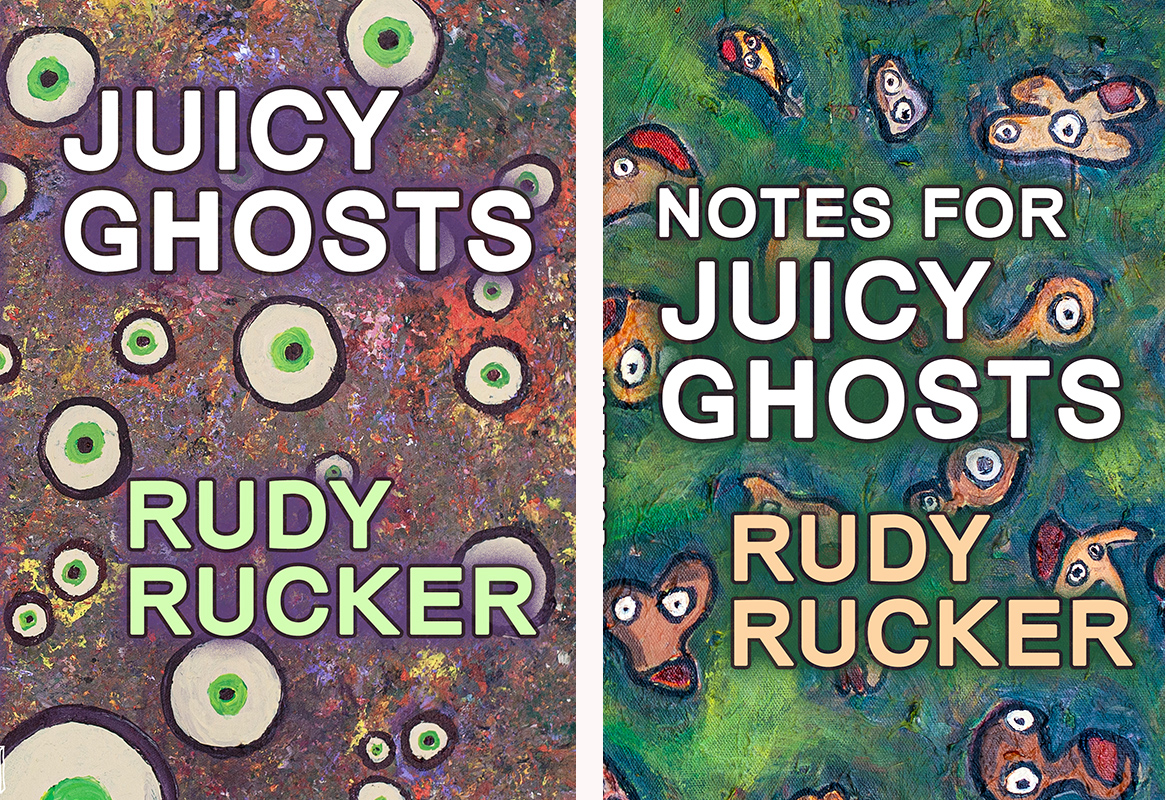
Yes, they’re awake in the actual real world—but something’s changed. Thanks to the craft of the Swillie sisters, scores of big germs are bumbling around, mostly paramecia. Live, translucent mini-blimps the size of hogs. Physically present. Very highly detailed, with nuclei, mitochondria, ribosomes, cytoskeletons—and some spiral organelles that glow.
For no good reason, one of the big germs darts forward and slips its mouth over Zoe’s head. The mouth is like a pouch in the critter’s side. Zoe beats her fists against the floating jelly bag. She tries to scream, but she’s muffled.
The big germ’s outer surface is coated with slimy fur, or no, coated with cilia. Zoe can see the cilia without using her eyes. Uvvy teep. Telepathy. The beating cilia reminds her of tall grass in a breezy field. A second big germ latches onto Bix’s head. Somehow—even in these dire straits—the attack on Bix makes Zoe laugh.
“Oo gloob-a-gloob,” says Zoe’s big germ.
“Ugfa floop,” says Bix’s.
“Talk English,” says Zoe.
“Or use teep,” goes Bix.
“We’re present in your reality,” says a blurry voice in Zoe’s mind. “I’m Franklin.”
“I’m Eleanor.” says the other big germ. “It’s surprising that you meat bags are as smart as us. Good for you.”
“My understanding is that you want to get rid of guns?” says Franklin, still perched atop Zoe. “Easily done. We’ll decohere them.”
“I don’t like having my head in your mouth,” says Zoe. “Why do you have to do that?”
“Makes our teep exchange stronger,” says Franklin.
“Don’t fear that we’ll digest you,” says Eleanor in a reassuring tone. If, that is, telepathy from a giant paramecium can be reassuring.
By now the Swillie sisters Jeen and Long Sue have big germs on their heads too. Silly and laughable, but at the same time it’s scary. The four humans hold hands in a circle. The big germs hum to them via teep, with cascades of images flying by. A vision of things to come.
Zoe heaves a deep sigh. This is going to be okay. This is going to work.
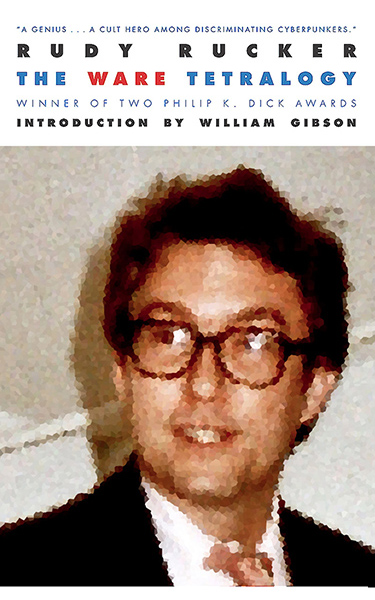
The audience of course has no idea what’s going on. They’re cringing away from the pullulating big germs. As a matter of fact, they’re leaving the building. And the two jerks who yelled are, how typical, pointing pistols at Zoe and Bix.
Swillie Jeen teeps to the big germs, and Zoe watches the signal go by. It sounds like an elf chorus, and it means, “Sic ’em.”
Big germ Franklin projects a jittery beam of energy that zings the men’s pistols into dust. Just like in the virtual reality of their tangle. But this happens in the real world. The big germs are fully actualized.
The disarmed guys run toward Zoe, fists clenched. Big germ Eleanor takes her turn. A sizzle runs across the men’s bodies. They wet their pants, howl “Ki-yi-y!”, and run outside like frightened dogs. How satisfying.
The San Jose civic auditorium is deserted except for Zoe, Bix, and the pair of Swillies. Plus four big germs. The humans slump to the ground, entranced. Their minds are temporarily hosted in the big germs—Zoe’s in Franklin, Bix is inside Eleanor and the Swillies’ minds are inside the two others. The big germs exit the auditorium, taking the humans’ minds along.
Zoe’s in Franklin, and Bix is inside Eleanor, and the Swillies’ minds are inside big germs as well. The four of them drift from the hall.
Thousands of big germs are on the loose outside. An roaring crowd of people swells. Wild rumors fly. People don’t know what’s up, but they want to witness. They cheer, chant, bray, pray, and scream.
“How far will you big germs spread?” Zoe asks Franklin.
Nimbly Franklin and Eleanor connect the women’s vision to an orbiting spy satellite. Looking down, Zoe and Bix see big germs as pinpricks of light. The germs are spreading across the planet with exponential speed—infecting every available uvvy with the Saint Nick portal. Big germs bubble forth from each uvvy, unstoppable, like water from unseen springs.
Looking away from Earth, Zoe and Bix admire the exquisite spangles of interstellar space. And, more than that, they see the paisley seething of the all-pervading subspace whence the big germs have come. Exquisite manna for the soul.
The rattle of automatic weapons fire snaps them back. They hover in their big germs above the now-tripled crowd in San Jose. Passions run high. The word is out: big germs will end guns.
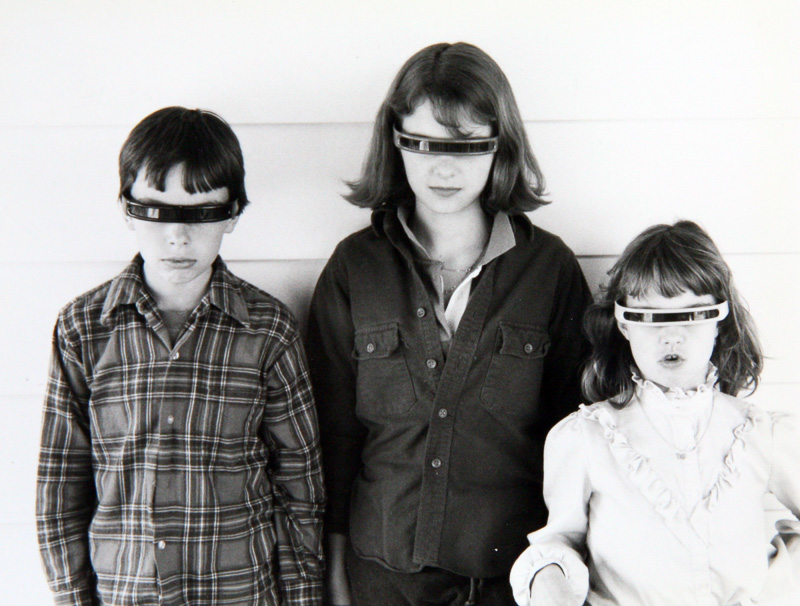
Bix and Zoe had their minds in space for longer than they realized. Aggrieved militias are marching in, weapons raised. They’re blazing away at the big germs, as if hunting ducks. This doesn’t last long. In a concerted effort, the big germs ooze out a blanket of summer lightning that settles onto crowd, coalescing into nodules that find each and every weapon, sizzling them into coruscating dust.
Cries of impotent fury.
The next wave of protest is a squadron of killer drones, heading toward the entrance of the San Jose civic auditorium, bent on destroying the entranced bodies of Zoe, Bix, Jeen, and Long Sue Swillie. Once more, Jeen’s big germ sounds an elf song, and a hundred-fold thunderbolt zaps all the drones at once.
A tasty zzzt. Bright dust falls.
Escalating waves of attacks roll in. The big germs are nimble, implacable, and for real. They take the invasion as a to-do list of things to eliminate. They zap metal guns, plastic guns, grenades, artillery, helicopter gunships, fighter planes—turning it all to dust, and spreading the news to their fellows worldwide. Before long, all that shit-nasty crap is gone.
Meanwhile the day has turned to night. And here comes one last attack, something reallly large, plummeting down from a great height. It’s an H-bomb that some wack war-monger is delivering C.O.D. to poor old San Jose.
Zoe and Bix have the honor of delivering the zap to the H-bomb.
Fa-toom. An exceedingly large amount of decontaminated pixie dust drifts down.
“Oh, lord, that felt good,” goes Zoe.
While the big germs get busy eliminating all the other nukes worldwide, the four humans return to the now-sacred confines of the San Jose civic auditorium—and rouse their bodies.
“How will people live without the joy of killing others at a distance?” asks Bix.
“Thoughtfully,” says Zoe. “In kindness.”
“And if the aggro idiots can’t handle that, they can fight each other with clubs and knives and fists,” suggests Long Sue. “Like in the old days.”
“What if they drag the rest of us into it?” goes Bix.
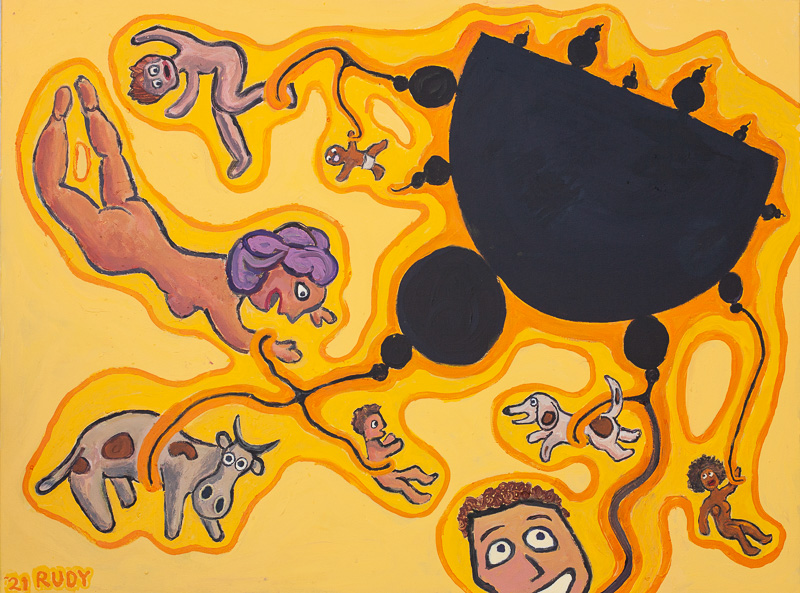
“Not so easy anymore,” says Zoe.
Jeen sounds an elf-chorus tone that means, I can always upgrade the big germs.
“Wouldn’t want to go too far,” cautions Long Sue. “Don’t want to live in kindergarten.”
“Bix and I will keep things loose,” puts in Zoe. “More tangles. Weirder ones. We’re nasty.”
High five.






















